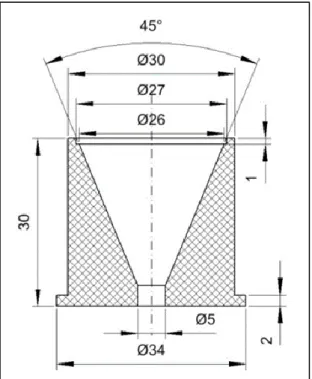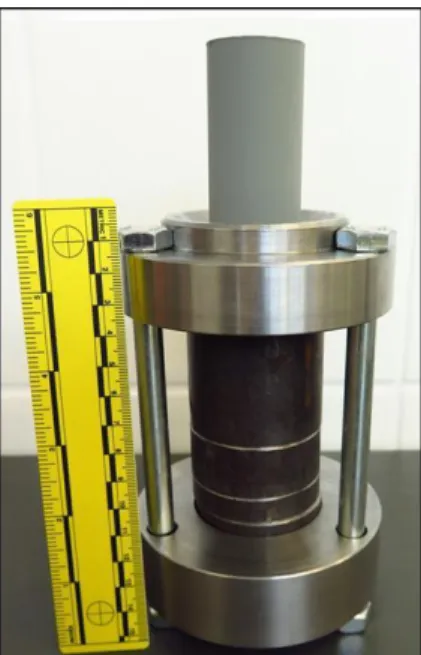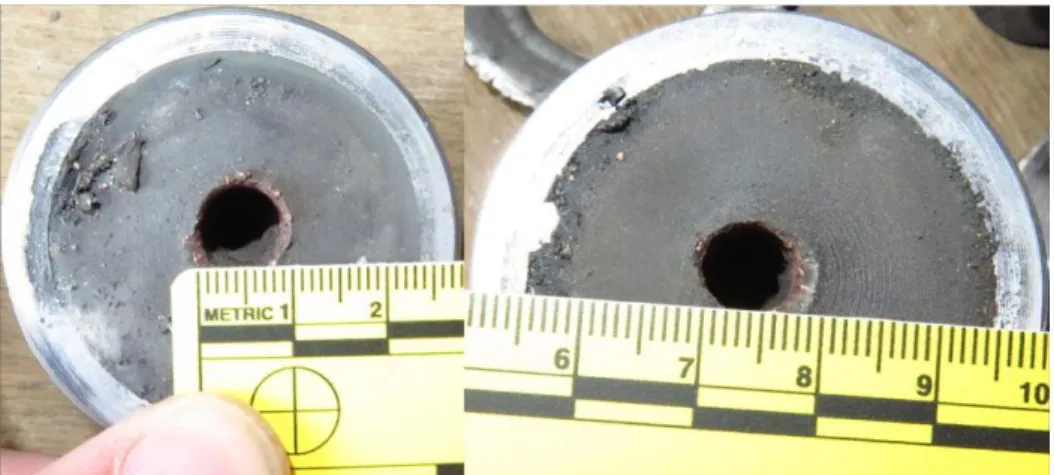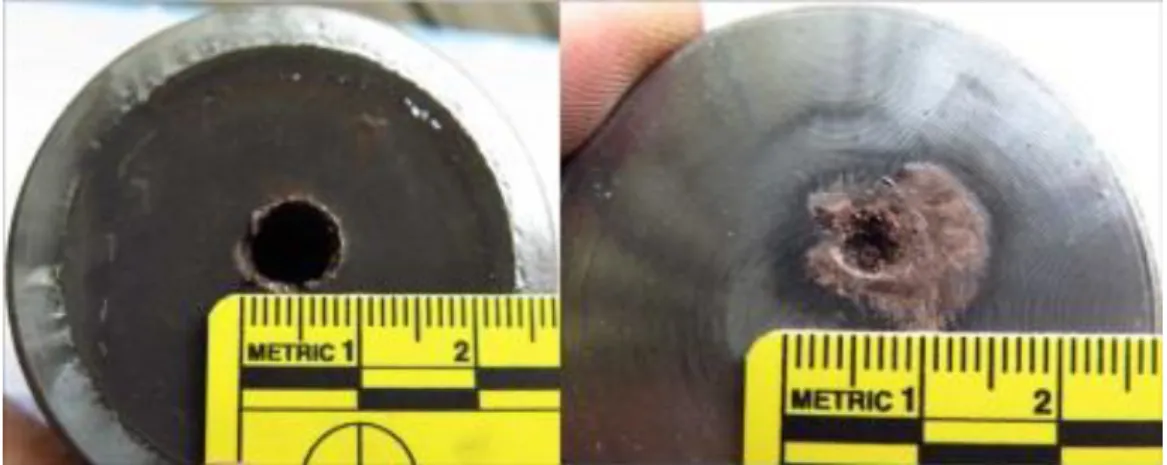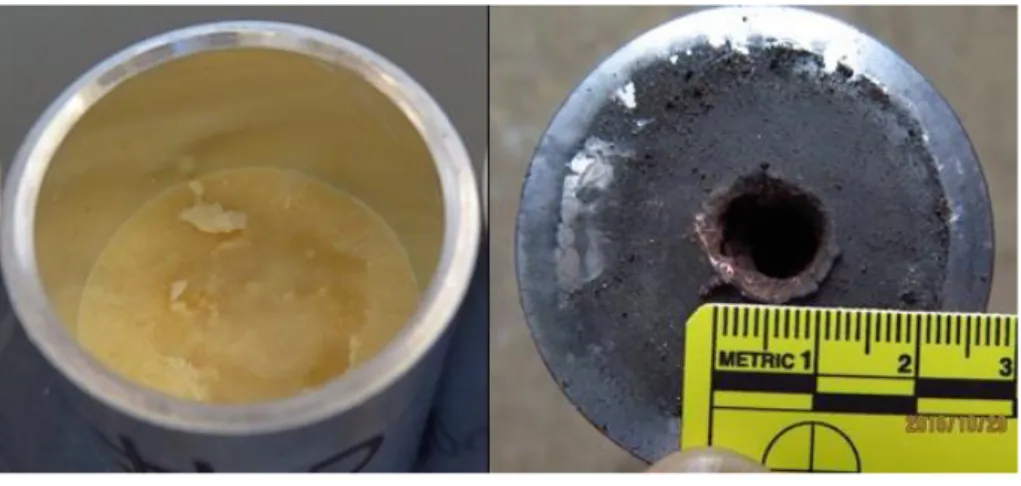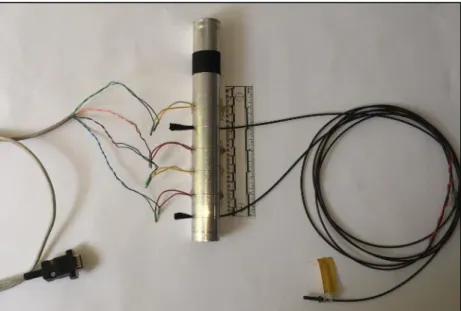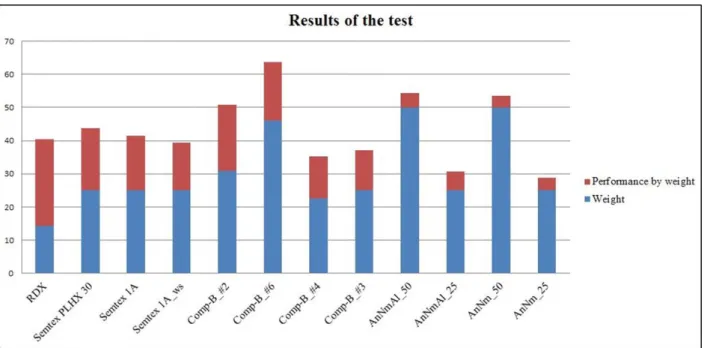EXPERIMENTS WITH SMALL SIZE SHAPED CHARGES
KISMÉRETŰ KUMULATÍV ROBBANÓTESTTEL VÉGZETT KISÉRLETEK
KUGYELA Lóránd
(ORCID: 0000-0002-2869-8864) kugyela.lorand@gmail.com
Abstract
This paper describes the research on testing of small size point focal shaped charges. They were manufactured from composite-B, Semtex and pressed RDX, and binary explosives. As the liner and the whole structure of the charges were identical the mild steel penetration test was a clear method for comparing and quantifying their performance. The target setup was also standardized with different steel discs. During testing I realized that it was a practical development tool, to find a proper mixture for binary explosives. Since most of the shaped charge literature related to their evaluation, I wanted to have a simple, yet productive performance testing method that suited more to practical field works.
Keywords: melt cast explosives, shaped charge, penetration test, binary explosives
Absztrakt
Jelen cikkben a kisméretű kumulatív töltetekhez kapcsolódó vizsgálataimról írok. A kísérletekhez: bináris, préselt hexogén, Semtex és Kompozit-B robbanóanyagokat használtam fel. Tekintve hogy szerkezetileg azonos kivitelezésű-kialakításúak voltak, minden esetben azonos lágyvas korongokon történt az átütőképességük vizsgálata. A kísérletek során bebizonyosodott, hogy bináris robbanóanyagok fejlesztéséhez is jól alkalmazható módszert sikerült találni.
végeredményként pedig egy olyan teljesítmény vizsgálatot szerettem volna kialakítani, ami illeszthető a gyakorlatias gyártási folyamatokhoz.
Kulcsszavak: öntött robbanóanyagok, kumulatív töltetek, átütés vizsgálat, bináris robbanóanyagok
appearance, like the liner material, the cone angle, the standoff distance, the wave shaping, the initiation, the confinement etc. The second one relates strictly to the explosives, like the explosive properties, the loading density, etc. By changing any of the above-mentioned criteria significant changes may appear. [4] My procedure was to manufacture a standardized shaped charge structure, by which I can measure different explosive compositions penetration performance and use this approach as a brisance predicting method. For the jet formation some explosive properties have great importance like the critical diameter, the detonation velocity, and density. These properties together are needed for an appropriate shaped charge.
Before the test, candidates were needed to establish a fundament for the investigation. For this purpose, two materials were chosen, one was a semi-finished product for high penetration capability 40mm grenade, with pressed shaped charge, and another one was a commonly avail- able plastic explosive. The focus of the trials was to build up a reproducible setup and then collect data to further development of binary explosives and other explosive mixtures penetration abilities. The approach of these tests are similar as in the STANAG 4526 [5].
SET-UP
The copper cone liners had 60° of cone angle, and 1,5mm of thickness. Their average weight was 13g.
With some technical help from a turner company a liner holder mounting was manufactured that served more purposes. Most importantly, it centralized a liner in an axis-symmetric position, acted as a standoff and a reversed of cone air cavity.
The tubing was an aluminium pipe that could be cut to predefined length. It holds the liner mounting at the bottom, and the detonator centralizer disc at the top.
Figure 1 shows the liner mounting cross-section. Figure 2 shows the shaped charge components.
Figure 1: Liner mounting cross-section
Figure 2: Shaped charge contents
The target assembly is a centralizing and clamping unit that holds the target mild steel discs tightly together and holds the shaped charge in the proper place. The two, separate central aligned fixtures hold the target assembly by three screws and a small ditch inside, while they pull and lock the discs together. This structure allows a fast, convenient way of testing as the settings can be varied quickly as different disc sequence can be adjusted. For example, if we predict that the penetration will be bigger than 50mm, first we place the 50mm disc then 10mm or 20 mm. In case of smaller penetration thinner discs can placed under the charge. The setup eliminates the human-borne positioning errors. Due to the standoff distance the explosion does not damage the head part and up to now, the device withstands several dozens of blasts.
Figure 3: Target assembly with a shaped charge on the top
Explosives for shaped charges
Four different types of explosives were used to validate the idea.
Plastic explosives, such as Semtex 1A and Semtex PLHX30 are commonly available and exceptionally suitable for this task.
Pressed explosives as mentioned in the introduction this charge is an RDX containing semi- finished product with high dimensional accuracy. Figure 4.
Melt cast material was the Comp-B (60/40). Manufacturing of the cast explosive itself was a challenging method, as the solidification, and the heat conduction problems of the small sizes and quantities (~22g-46g) of materials can cause more significant discrepancies than in productions of several kilograms.
Binary explosive mixture was a classical nitro-paraffin / oxidizer mixture with and without atomized aluminum.
Figure 4: RDX shaped charge
TESTS
During the experiment differently shaped charges were tested. Table 1 describes their type, weight and other necessary remarks.
Explosive Weight (g) Remark
Semtex 1A 25 without waveshaper
Semtex 1A 25 with waveshaper
Semtex PLHX 30 25 8% Al content
RDX 14,3 pressed
Comp-B 25,1 cast
Comp-B 30,8 cast
Comp-B 46,1 cast
Comp-B 22,6 cast
AnNmAl* 50 2,5% Al
AnNmAl 25 2,5% Al
AnNm 50 without Al
AnNm 25 without Al
*AnNmAl: Ammonium-nitrate, nitromethane, aluminium mixture
Table 1. Summary table for the explosives in the experiments
First the plastic explosives were tested. During the experiments the collar diameter of the hole and the depth of penetration were measured.
Figure 5: Result for Semtex 1A with (right), and without waveshaper (left)
The diameter decreased by 2mm average in case of the waveshaper but the penetration in- creased from 46mm to 51,6mm. For the Semtex PLHX30 the hole diameter was 9,1mm and the length 51,5mm.
As the plastic explosives were exceptionally suitable for high performance shaped charges, the results of each case showed symmetry and repeatability.
Figure 6: Result for Semtex PLHX30.
The RDX pressed charge showed some inconsistency which could be attributed to the pressing procedure. From each of the 3 blasts some amount of copper splatter remained on the surface of the discs. The average diameter at the collar was 7,3mm, and the length was 51mm.
Figure 7: Pressed RDX charge entry (left), and the jet on the second disc (right).
Manufacturing of the melt cast composition in such small charges proved to be challenging.
Melting the TNT and adding RDX happened in a Teflon coated pan with steam heating at 90°C- 91°C. Meanwhile, the shaped charge assembly was heated in a steam bath to avoid the instant solidification at the filling procedure. A vibration motor built into the mounting of the shaped charge, for eliminating the shrinking issues during the cooling phase. In theory, this seemed obvious, but in the practice, it was different. The vibration alone did not solve the solidification.
The fill-up carried out in multiple steps. Between each step, the floating “plate” shattered then the next portion was poured immediately. With this procedure, the reducing volume filled up with molten material instead of air gap. Without continuous stirring the 4% wax content of the RDX accumulated at the top of the melted explosive mixture. As around 5 grams of RDX dissolved in 100g TNT [6] the regular agitation was mandatory to avoid layering of the explosives. Without this action when the charged body was filled, different density and concentration explosive sections would be built up which could have raised the sensitivity of ignition. The RDX eutectic would place around the liner and at the top segment a TNT rich layer was built up with a wax layer on the surface.
For the performance test four composite-B charges were made. The weights of explosive were from 22,6g to 46,1g.
Figure 8: Result of 25,1g Composite-B.
This amount of composition barely covered the liner. The diameter was 9,4mm, the length was 32,3mm
Figure 9: Result of 30,8 g Composite-B.
Although the slug remained at the collar point at the disc the penetration was almost the double as at the previous one. Diameter was10mm and the length was 61,5mm.
Figure 10: Result of 46,1 g Composite-B.
This shaped charge contained the largest amount of cast explosive and had a sizable penetration length of 71mm and the diameter of 11,2mm. The Figure 10 shows the penetration through a 50mm-10mm-10mm mild steel discs.
Figure 11: Result of 22,6 g Composite-B.
At this test, the effect of the asymmetrical jet formation can be seen. Presumably, the tail part (slug) came off and deformed the collar of the hole. The diameter was 9,2mm, the length was 31mm.
In case of binary explosives, classic nitroparaffin and ammonium-nitrate mixtures were used.
Comparing this mixtures effectiveness to RDX or PETN containing explosives definite recession is perceptible, even so, the jet formation exists. All those materials which detonation properties highly dependent on the diameter and the confinement this test shows the correlation between this circumstance and their performance. The large fraction prill containing AnNm detonation has failed this partial detonation can be observed in Figure 12. The close up of recovered liner and their comparisons are on Figure 13.
Figure 12: Result of 22,6 g Composite-B.
Figure 13: Intact (left) and deformed liners due to partial detonation (middle, right).
The AnNm and AnNmAl compositions were tested in 50g and 25g trials to examine the penetration decrease due to the lower charge weight.
Figure 14: AnNmAl 50-25g targets
JET VELOCITY TESTING EXPERIMENTS
Beside the many factors which can modify the jet’s penetration, one important value should also be mentioned. In the face of effectiveness, the jet tip velocity gives a good estimation how the shaped charge will perform. Needless to say that highest velocity values can be achieved with precision manufactured pressed charges, loaded with RDX, HMX, HNS [7].
The principal of the procedure is like the case of the detonation velocity (Vod) measurements [8] [9]. The testing unit is equipped with high resolution timer and it measures time between its probes and then calculates the speed of the detonation.
High-end equipment (high speed imaging) [10] can give more complex results from the jet formation, [11] however a less sophisticated set-up can also handle the measurement.
I choose the unit with break wire method. The calculation principle based on a time measuring between voltage-drops of electric probes. The probes in this case are thin copper cables.
The measurement setup built up from the following main parts:
̶ Explosive shaped charge
̶ Measurement cable assembly with positioning pipe
̶ Detonation time meter (resolution: +/- 0,1 μs)
Figure 15: Jet velocity measurement setup with two different methods
larger SoD, more unpredictable test results will appear.
The measurements were not carried out for each case, just in order to have comparable results between the RDX and the binary explosives, and to verify that this method is also suitable for such measurements. As I wrote in the preface, the “standard” charge was the RDX pressed charge, from a 40mm grenade.
Probes
RDX pressed charge
Probes
Binary explosive Distance(m
m)
Vod (m/s)
Distance(m m)
Vod (m/s) BW0-
BW1* 50 6493 O1-
O2** 50 2475
BW0-
BW2 75 6000 O2-O3 50 2427
BW0-
BW3 100 4149 - - -
*:”BW” corresponds for break wire method
**:”O” corresponds for optical method
Table 2. Summary table for the explosives in the experiments
To verify the two methods, I conducted standard detonation velocity measuring test, in which both methods were done simultaneously, see Table 2. The differences were within 1,9µs in 100m distance which means 460m/s the highest. As the placing of both probe types are critical in the result’s point of view, I consider this measuring method also suitable for such jet velocity measurements.
RESULTS
The complete results can be found in Table 3. The performance row comes from the multiplication of the holes collar diameter by its length that serves as a ratio of the penetration.
Performance by weight results from the division of the mentioned ratio by the explosive weight.
With this method a sequence that correlates to the theoretical approach of the brisance of the used explosives can be set.
The jet velocity measurements both with optical and break wire method, can be a good additional low-cost method for evaluating the performance of shaped charges. The results for the RDX pressed charge are within the values stated by the manufacturer. For the binary charges further tests need to be performed, but the test results are in line with the difference shown in their penetration ability.
Explosive m(g) d (mm)
l (mm)
Performan ce
Perfor mance by weight
Remar k
RDX 14,3 7,3 51 372,3 26,03 presse
d Semtex
PLHX 30 25 9,1 51,5 468,6 18,75 8% Al
content
Semtex 1A 25 9 46 414 16,56 -
Semtex 1A 25 7 51,6 361,2 14,45 waveshape
r
Comp-B_#2 30,8 10 61,5 615 19,93 cast
Comp-B_#6 46,1 11,2 72 810,7 17,59 cast
Comp-B_#4 22,6 9,2 31 285,2 12,62 cast
Comp-B_#3 25,1 9,4 32,3 303,6 12,10 cast
AnNmAl_50 50 6,1 34,7 211,6 4,23 2,5%
Al
AnNmAl_25 25 5,7 24,7 142,7 5,71 2,5%
Al
AnNm_50 50 5,6 30,5 170,8 3,42 -
AnNm_25 25 4,7 19,5 93,2 3,73 -
m=explosive weight; d=hole diameter; l=hole length
Table 3. Complete test results
RESULTS
Figure 16: Results in graph format
Figure 16 contains all the measured values organized in bar graphs. Each bar corresponds one explosive, of which the lower blue part is the weight, and the upper is the performance by weight. Figures confirm the theory that explosives with higher detonation velocity (RDX,
jet.
From practical point of view, it is a small-scale test that can perform with grams instead of kilograms of materials. It can be accomplished in blasting chambers because does not required specific instruments.
It is a suitable method for development, or other cases when the reasonable comparability and repeatability are important factors.
REFERENCES
[1] WALTERS, W.P.;ZUKAS, J. A.: Fundamentals of shaped Charges. Wiley, 1989
[2] J. BROWN, I.D. SOFTLEY, and P. EDWARDS: Experimental Study of Shaped Charges with Built-in Asymmetries, Propellants, Explosives, Pyrotechnics 18, pp. 255-258, 1993 [3] K. H. KAMARUDIN, A. M. A. ZAIDI, S. ABDULLAH & Md F. S. KOSLAN:
Establishment of Shaped Charge Optimum Parameters for Small Scale Hydrodynamic Penetration, Modern Applied Science, Vol. 10, No. 1; pp. 82-92, 2016.
[4] V.BOHANEK, M. DOBRILOVIC, V.SKRLEC: The efficiency of linear shaped charges, Tehnicki vjesnik 21, 3 pp. 525-531, 2014
[5] E. L. BAKERA, J. PHAMA, T. MADSENA, W. POULOSA and B. E. FUCHSA: Shaped Charge Jet Characterization and Initiation Test Configuration for IM Threat Testing, Procedia Engineering 58, pp. 58-67, 2013
[6] TM 9-1300-214 Military Explosives, Department of Army Technical Manual, p. 119 1984.
[7] E. ZVONIMIR, M. DOBRILOVIĆ, B. JANKOVIĆ, Z TOMIČIĆ, M. ODAK: Jet velocity and the effects of the shaped charge perforator for use in the oil and gas well, International Seminar; 9th, New trends in research of energetic materials; (NTREM), Pardubice, pp.581-586, 2006
[8] EN 13631-14; Explosives for civil uses, High explosives, Part 14: Determination of velocity of detonation. 2003
[9] Dr. A. von OERTZEN: Demonstration of Proficiency by Round-Robin Tests among explosives Notified Bodies, EFEE, 7th World Conference on Explosives & Blasting, Moscow, ISBN 978-5-98746-0160-0, pp. 78-81, 2013
[10] M. S. SHATTUCK: Determination of detonation velocity of explosive compounds using optical techniques, New Mexico Institute of Mining and Technology, 2015
[11] S.G.TATAKE, D.K.KHARAT, Flash X-ray: A diagnostic tool for shaped charge studies.
Defence Science Journal, Vol.42, No.4. pp 259-264, 1992,
